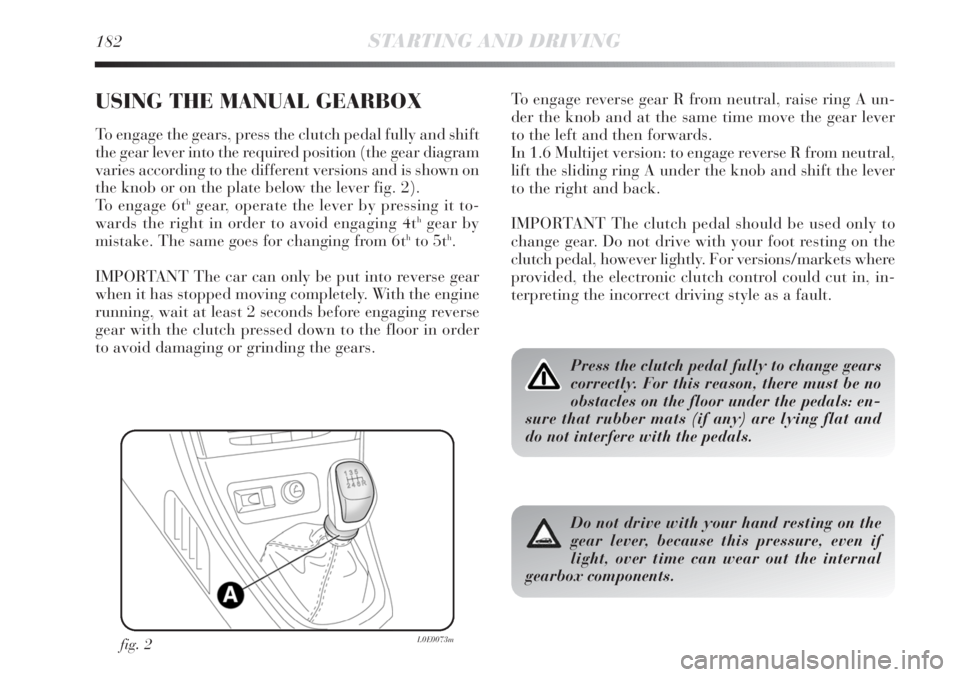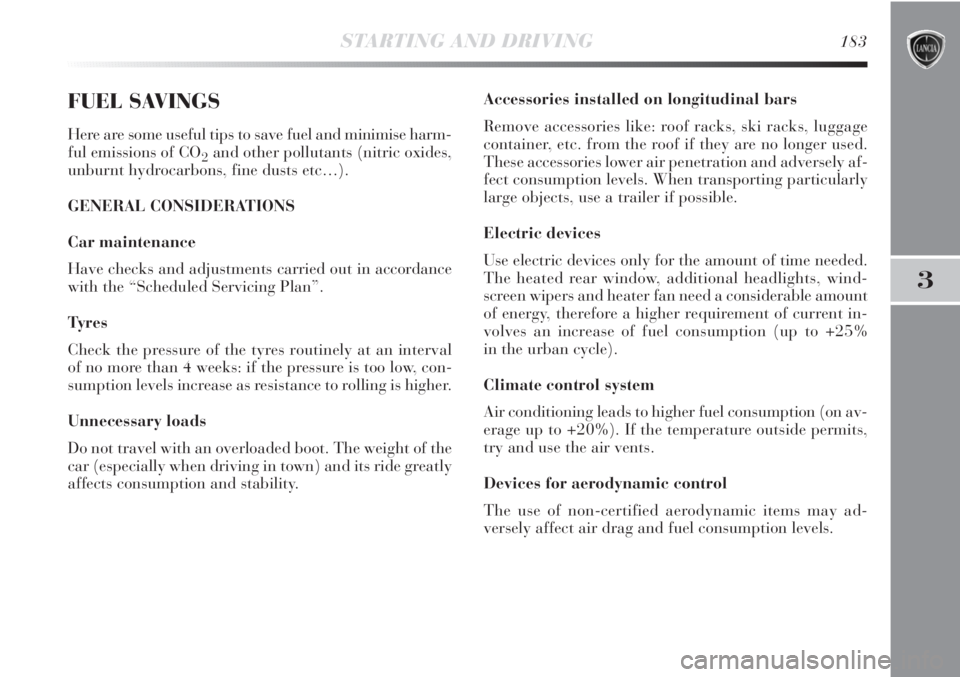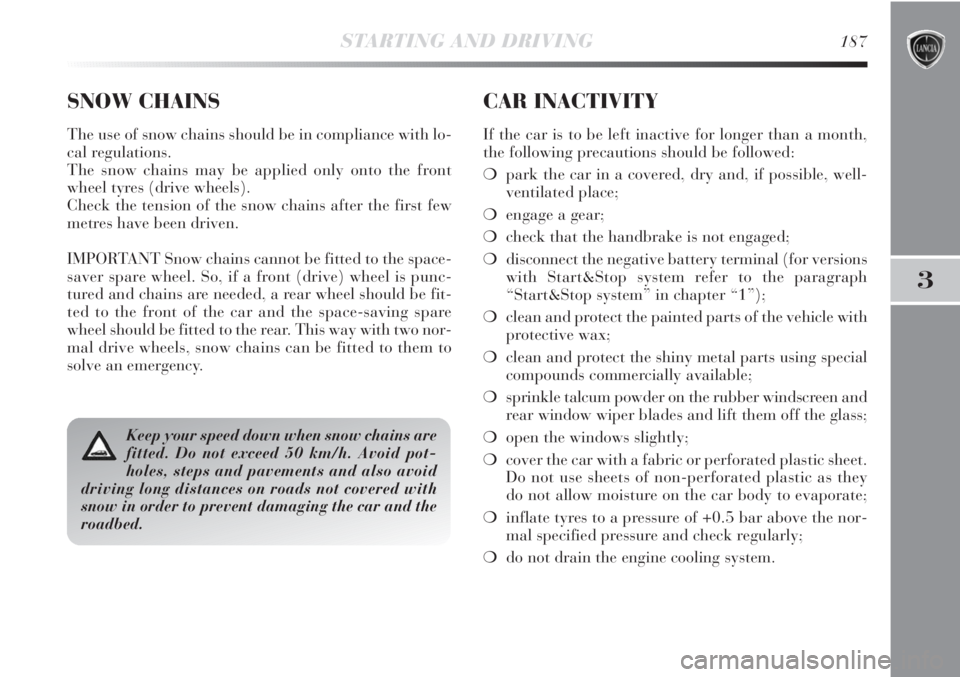light Lancia Delta 2012 Owner handbook (in English)
[x] Cancel search | Manufacturer: LANCIA, Model Year: 2012, Model line: Delta, Model: Lancia Delta 2012Pages: 295, PDF Size: 8.29 MB
Page 181 of 295

3
STARTING AND DRIVING179
If the engine does not start at the first attempt, return the
ignition key to STOP before repeating the procedure.
If, when the ignition key is turned to MAR, the instru-
ment panel warning light
Yremains on together with
warning light U, turn the key to STOP and then back to
MAR; if the warning light remains on, try the other keys
provided with the vehicle.
Contact a Lancia Dealership if you still cannot start the
engine.
STARTING PROCEDURE FOR DIESEL VERSIONS
Proceed as follows:
❍engage the handbrake;
❍put the gear lever into neutral;
❍turn the ignition key to MAR: the warning lights
mandYon the instrument panel will turn on;
❍wait for the warning lights
Yandmto turn off.
The hotter the engine is, the quicker this will happen;
❍fully depress the clutch pedal without operating the
accelerator;
❍turn the ignition key to AVV as soon as warning light
mgoes out. Waiting too long will waste the work
done by the glow plugs.
Release the key as soon as the engine starts.IMPORTANT With the engine cold, the accelerator pedal
must be fully released when you turn the ignition key to
AV V.
If the engine does not start at the first attempt, return the
ignition key to STOP before repeating the procedure. If
instrument panel warning light
Yremains lit when the
ignition key is turned to MAR, turn the key to STOP and
then back to MAR; if the warning light remains lit, try the
other keys provided with the vehicle. Contact a Lancia
Dealership if you still cannot start the engine.
Warning light mwill flash for 60 seconds
after starting or during prolonged cranking
to indicate a fault with the glow plug heat-
ing system. You can use the car as usual if the en-
gine starts but you should contact a Lancia Deal-
ership as soon as possible.
Page 183 of 295

3
STARTING AND DRIVING181
HANDBRAKE
The handbrake lever is located between the two front
seats.
Pull the lever upwards to operate the handbrake, until
the vehicle is braked.
The car should be braked after a few clicks
of the lever; if it is not, contact a Lancia
Dealership to have it adjusted.
When the handbrake is on and the ignition key is at MAR,
the instrument panel warning light xwill come on.
Proceed as follows to release the handbrake:
❍slightly lift the handbrake and press release button
A-fig. 1;
❍keep button A pressed and lower the lever. The warn-
ing light xon the instrument panel will turn off.
Press the brake pedal when carrying out this operation
to prevent the car from moving accidentally. PARKING THE VEHICLE
Proceed as follows:
❍stop the engine and engage the handbrake;
❍engage a gear (on a slope, engage first gear if the car
is facing uphill or reverse if it is facing downhill) and
leave the wheels steered.
If the car is parked on a steep slope, it is also advisable
to block the wheels with a wedge or stone.
Do not leave the ignition key turned to MAR to prevent
draining the battery. Always remove the key when you
leave the car.
Never leave children in the unattended car. Always re-
move the ignition key when leaving the car and take it
out with you.
fig. 1L0E0072m
Page 184 of 295

182STARTING AND DRIVING
USING THE MANUAL GEARBOX
To engage the gears, press the clutch pedal fully and shift
the gear lever into the required position (the gear diagram
varies according to the different versions and is shown on
the knob or on the plate below the lever fig. 2).
To engage 6t
hgear, operate the lever by pressing it to-
wards the right in order to avoid engaging 4thgear by
mistake. The same goes for changing from 6thto 5th.
IMPORTANT The car can only be put into reverse gear
when it has stopped moving completely. With the engine
running, wait at least 2 seconds before engaging reverse
gear with the clutch pressed down to the floor in order
to avoid damaging or grinding the gears.
fig. 2L0E0073m
To engage reverse gear R from neutral, raise ring A un-
der the knob and at the same time move the gear lever
to the left and then forwards.
In 1.6 Multijet version: to engage reverse R from neutral,
lift the sliding ring A under the knob and shift the lever
to the right and back.
IMPORTANT The clutch pedal should be used only to
change gear. Do not drive with your foot resting on the
clutch pedal, however lightly. For versions/markets where
provided, the electronic clutch control could cut in, in-
terpreting the incorrect driving style as a fault.
Press the clutch pedal fully to change gears
correctly. For this reason, there must be no
obstacles on the floor under the pedals: en-
sure that rubber mats (if any) are lying flat and
do not interfere with the pedals.
Do not drive with your hand resting on the
gear lever, because this pressure, even if
light, over time can wear out the internal
gearbox components.
Page 185 of 295

3
STARTING AND DRIVING183
FUEL SAVINGS
Here are some useful tips to save fuel and minimise harm-
ful emissions of CO
2and other pollutants (nitric oxides,
unburnt hydrocarbons, fine dusts etc…).
GENERAL CONSIDERATIONS
Car maintenance
Have checks and adjustments carried out in accordance
with the “Scheduled Servicing Plan”.
Ty r e s
Check the pressure of the tyres routinely at an interval
of no more than 4 weeks: if the pressure is too low, con-
sumption levels increase as resistance to rolling is higher.
Unnecessary loads
Do not travel with an overloaded boot. The weight of the
car (especially when driving in town) and its ride greatly
affects consumption and stability.Accessories installed on longitudinal bars
Remove accessories like: roof racks, ski racks, luggage
container, etc. from the roof if they are no longer used.
These accessories lower air penetration and adversely af-
fect consumption levels. When transporting particularly
large objects, use a trailer if possible.
Electric devices
Use electric devices only for the amount of time needed.
The heated rear window, additional headlights, wind-
screen wipers and heater fan need a considerable amount
of energy, therefore a higher requirement of current in-
volves an increase of fuel consumption (up to +25%
in the urban cycle).
Climate control system
Air conditioning leads to higher fuel consumption (on av-
erage up to +20%). If the temperature outside permits,
try and use the air vents.
Devices for aerodynamic control
The use of non-certified aerodynamic items may ad-
versely affect air drag and fuel consumption levels.
Page 186 of 295

184STARTING AND DRIVING
DRIVING STYLE
Starting
Do not warm the engine with the car at a standstill or at
idle or high speed: under these conditions the engine
warms up much more slowly, increasing electrical con-
sumption and emissions. It is therefore advisable to move
off immediately, slowly, avoiding high speeds: in this way
the engine will warm faster.
Unnecessary actions
Avoid revving up when at traffic lights or before stopping
the engine. The latter action, like double-declutching, is
completely unnecessary and causes increased fuel con-
sumption and pollution.
Gear selection
As soon as the conditions of the traffic and road allow,
use a higher gear. Using a low gear for faster acceleration
will increase consumption.
In the same way improper use of a high gear increases
consumption, emissions and engine wear.
Max. speed
Fuel consumption considerably increases with speed.
Avoiding unnecessary braking and acceleration, which
cost in terms of both fuel and emissions.Acceleration
Accelerating violently will greatly affect consumption and
emissions: acceleration should be gradual.
CONDITIONS OF USE
Cold starting
Short journeys and frequent cold starts do not allow the
engine to reach optimum operating temperature. This re-
sults in a significant increase in consumption levels (from
+15 to +30% on the urban cycle) and emissions.
Traffic and road conditions
Rather high fuel consumption is caused by heavy traf-
fic, for instance when travelling in a queue with frequent
use of low gears or in large towns with many traffic lights.
Mountain and rough roads also have a negative effect on
fuel consumption.
Traffic hold-ups
During prolonged hold-ups (e.g. level crossings) the en-
gine should be switched off.
Page 189 of 295

3
STARTING AND DRIVING187
Keep your speed down when snow chains are
fitted. Do not exceed 50 km/h. Avoid pot-
holes, steps and pavements and also avoid
driving long distances on roads not covered with
snow in order to prevent damaging the car and the
roadbed.
SNOW CHAINS
The use of snow chains should be in compliance with lo-
cal regulations.
The snow chains may be applied only onto the front
wheel tyres (drive wheels).
Check the tension of the snow chains after the first few
metres have been driven.
IMPORTANT Snow chains cannot be fitted to the space-
saver spare wheel. So, if a front (drive) wheel is punc-
tured and chains are needed, a rear wheel should be fit-
ted to the front of the car and the space-saving spare
wheel should be fitted to the rear. This way with two nor-
mal drive wheels, snow chains can be fitted to them to
solve an emergency.
CAR INACTIVITY
If the car is to be left inactive for longer than a month,
the following precautions should be followed:
❍park the car in a covered, dry and, if possible, well-
ventilated place;
❍engage a gear;
❍check that the handbrake is not engaged;
❍disconnect the negative battery terminal (for versions
with Start&Stop system refer to the paragraph
“Start&Stop system” in chapter “1”);
❍clean and protect the painted parts of the vehicle with
protective wax;
❍clean and protect the shiny metal parts using special
compounds commercially available;
❍sprinkle talcum powder on the rubber windscreen and
rear window wiper blades and lift them off the glass;
❍open the windows slightly;
❍cover the car with a fabric or perforated plastic sheet.
Do not use sheets of non-perforated plastic as they
do not allow moisture on the car body to evaporate;
❍inflate tyres to a pressure of +0.5 bar above the nor-
mal specified pressure and check regularly;
❍do not drain the engine cooling system.
Page 192 of 295

190IN AN EMERGENCY
ENGINE STARTING
Go to a Lancia Dealership immediately if instrument
panel warning light
Yremains on constantly.
JUMP STARTING fig. 1
If the battery is flat, the engine may be started using an
auxiliary battery with the same capacity or a little higher
than the flat one.
fig. 1L0E0074m
Strictly avoid using a rapid battery charger
for jump starting: this could damage the
electronic systems and the engine fuel sup-
ply and ignition control units.
This starting procedure must be carried out
by expert personnel as incorrect manoeu-
vres can cause electrical discharges of con-
siderable intensity. Furthermore, battery fluid is
poisonous and corrosive: avoid contact with your
skin and eyes. Keep naked flames away from the
battery. No smoking. Do not cause sparks.
Page 201 of 295

IN AN EMERGENCY199
4
REPLACING A WHEEL
GENERAL INSTRUCTIONS
The car may be originally fitted with a space-saver wheel
(for versions/markets, where provided).
Wheel changing and correct use of the jack and spare
wheel call for some precautions as listed below.
The space-saver wheel (for versions/mar kets
where provided) is specific to your car, do not
use it on other models, or use the spare wheel
of other models on your car. The space-saver wheel
must only be used in case of emergency. Never use
it for more than strictly necessary and never exceed
80 km/h. On the space-saver wheel there is an or-
ange label, summarising the main warnings re-
garding space-saver wheel usage restrictions.
Never remove or cover the label. Never ap-
ply a hub cup on a space-saver wheel. The
following information is provided in four
languages on the label: IMPORTANT! FOR TEM-
PORARY USE ONLY! 80 KM/H MAX.! REPLACE
WITH STANDARD WHEEL AS SOON AS POS-
SIBLE. DO NOT COVER THIS LABEL.
If you change the type of wheel (alloy rims instead
of steel rims) you will have to change the entire set
of fastening bolts with another set of suitably sized
bolts.
Alert other drivers that the car is stationary
in compliance with local regulations: haz-
ard warning lights, warning triangle, etc.
Any passengers on board should leave the car, es-
pecially if it is heavily laden. Passengers should
stay away from on-coming traffic while the wheel
is being changed. If parked on a slope or rough sur-
face, chock the wheels with wedges or other suit-
able devices.
Page 208 of 295

206IN AN EMERGENCY
After tyre replacement
❍Stow the space saver wheel D-fig. 10 in the space pro-
vided in the luggage compartment;
❍fit the partially open jack in its box forcing it lightly
to prevent it from vibrating when travelling;
❍put the tools back into place in the container;
❍stow the container, complete with tools, in the spare
wheel and tighten the locking device B-fig. 10;
❍reposition the boot mat correctly.
IMPORTANT Do not use inner tubes with tubeless tyres.
Check the inflation pressure of the tyres and the space-
saving wheel periodically.CHANGING A BULB
GENERAL INSTRUCTIONS
❍Before changing a bulb, check the contacts for rust-
ing;
❍burnt-out bulbs must be replaced by others of the
same type and wattage;
❍always check the alignment of the beam after chang-
ing a headlight bulb;
❍when a light is not working, check that the corre-
sponding fuse is intact before changing a bulb. For the
location of fuses, refer to the paragraph “Replacing
fuses” in this chapter.
Modifications or repairs to the electric sys-
tem that are not carried out properly or do
not take the system technical specifications
into account can cause malfunctions leading to the
risk of fire.
Various fastening bolts and space-saver
wheels, specific and differing in structural
characteristics, are used depending on the
wheel rim type (alloy or steel). Fastening bolts for
alloy rims can be identified by the presence of a per-
manent washer and a hollow side on the bolt head.
Therefore, you will need to go to a Lancia Dealer-
ship to get the correct type of fastening bolts and
space saver wheel if you change the type of wheels
fitted (alloy rims instead of steel rims, or vice
versa). Keep the bolts fitted as standard in case of
re-use of the wheels originally mounted on the car.
Page 209 of 295

IN AN EMERGENCY207
4
Halogen bulbs contain gas under pressure;
if they break, glass fragments may be dis-
persed.IMPORTANT The headlight inner surface might be
slightly misted: this should not be considered irregular
rather a natural phenomenon due to low temperature and
the air humidity level. Misting will disappear as soon as
the headlights are turned on. The presence of drops in-
side the headlights indicates infiltration of water. Contact
a Lancia Dealership.
IMPORTANT When the weather is cold or damp or after
heavy rain or after washing, the surface of headlights or
rear lights, may steam up and/or form drops of conden-
sation on the inside. This is a natural phenomenon due
to the difference in temperature and humidity between the
inside and the outside of the glass which does not indicate
a fault and does not compromise the normal operation of
lighting devices. The mist disappears quickly when the
lights are turned on, starting from the centre of the dif-
fuser, extending progressively towards the edges.
When handling halogen bulbs, only touch the
metal part. If the transparent bulb is touched
with the fingers, its lighting intensity is re-
duced and life of the bulb may be compromised. In
the event of accidental contact, wipe the bulb with
a cloth moistened with alcohol and leave it to dry.
Where possible, it is advisable to have bulbs
changed at a Lancia Dealership. Proper op-
eration and orientation of the external lights
are essential for driving safety and complying
with the law.